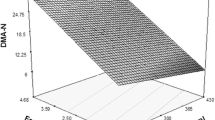Abstract
The residual effect of CO2 on whole gutted hake kept with three different CO2/O2/N2 gas mixtures: 60/15/25, 80/20/0 and 40/40/20, and two different kinds of atmospheres (controlled and modified) during 12 days followed by conventional storage in ice for up to 30 days was examined by physical, chemical and sensory analyses. Shelf life was longer in lots kept in atmospheres than in control lots and was further prolonged by controlled than by modified atmospheres. The lots kept in the atmosphere with the highest concentrations (80%) of CO2 exhibited the lowest trimethylamine nitrogen and total volatile basic nitrogen values. However, these were also the lots that scored worst in sensory analysis. The lots that scored best in sensory analysis were those which were kept in the gas mixtures with 60% and 40% of CO2. Oxidative rancidity was not a problem in the samples stored in the atmosphere with 40% O2; Thiobarbituric acid levels were lower than 2 mg/100 g in all lots throughout storage, and the assessors detected no rancidity. The residual effect of CO2 on whole gutted hake was more effective in controlled atmosphere lots.
Similar content being viewed by others
Author information
Authors and Affiliations
Additional information
Received: 15 June 2000 / Revised version: 17 August 2000
Rights and permissions
About this article
Cite this article
Ruiz-Capillas, C., Moral, A. Residual effect of CO2 on hake (Merluccius merluccius L.) stored in modified and controlled atmospheres. Eur Food Res Technol 212, 413–420 (2001). https://doi.org/10.1007/s002170000270
Issue Date:
DOI: https://doi.org/10.1007/s002170000270




